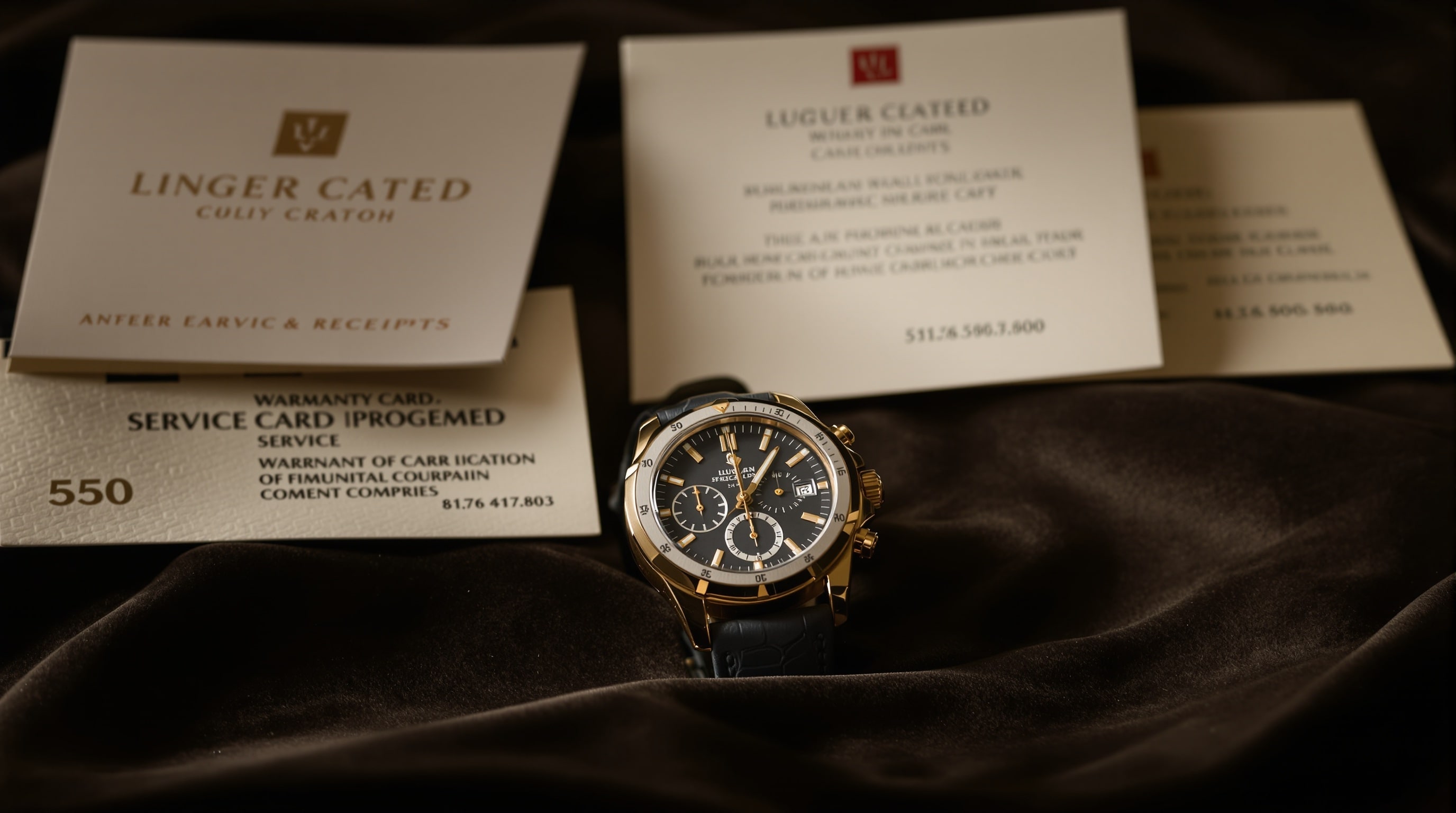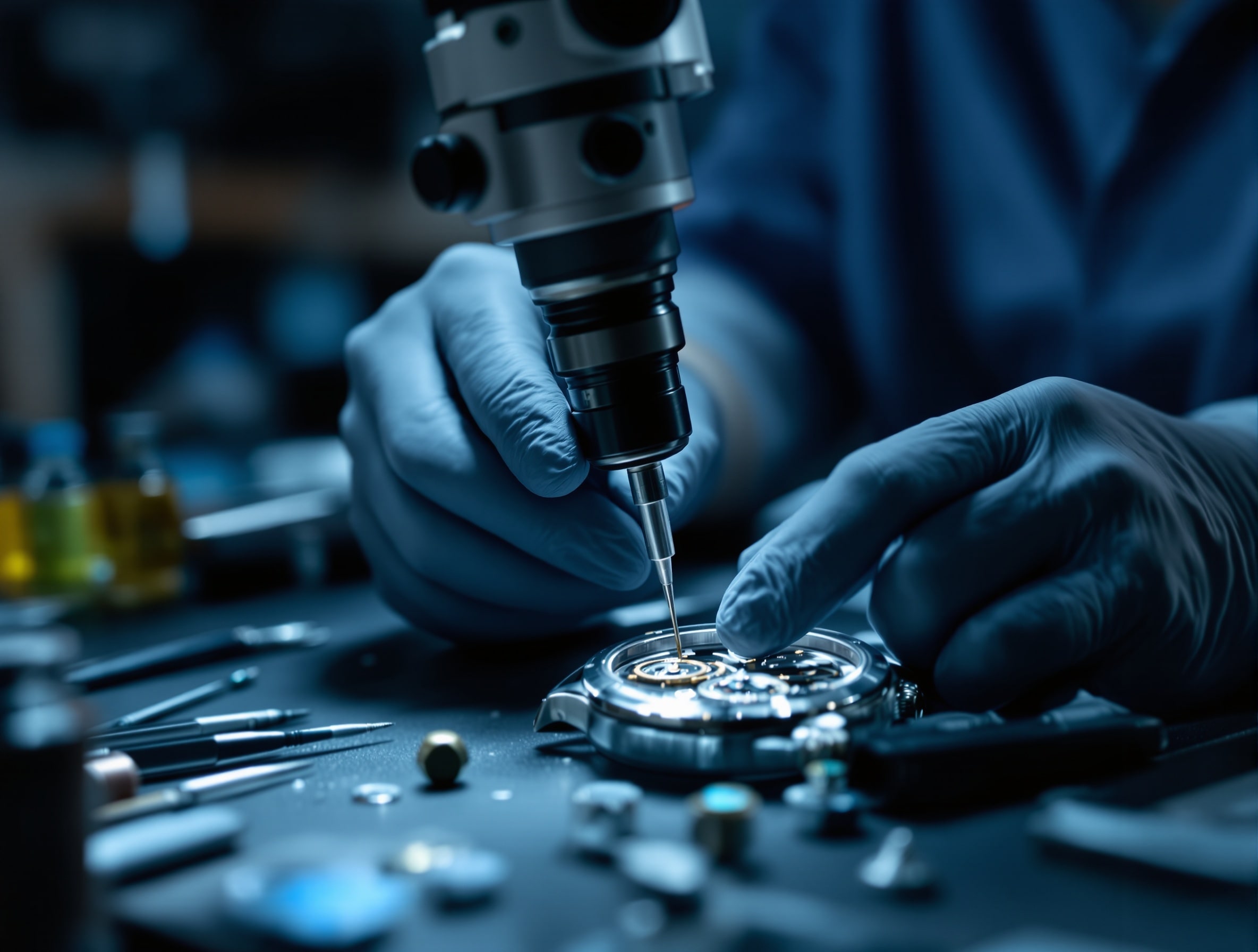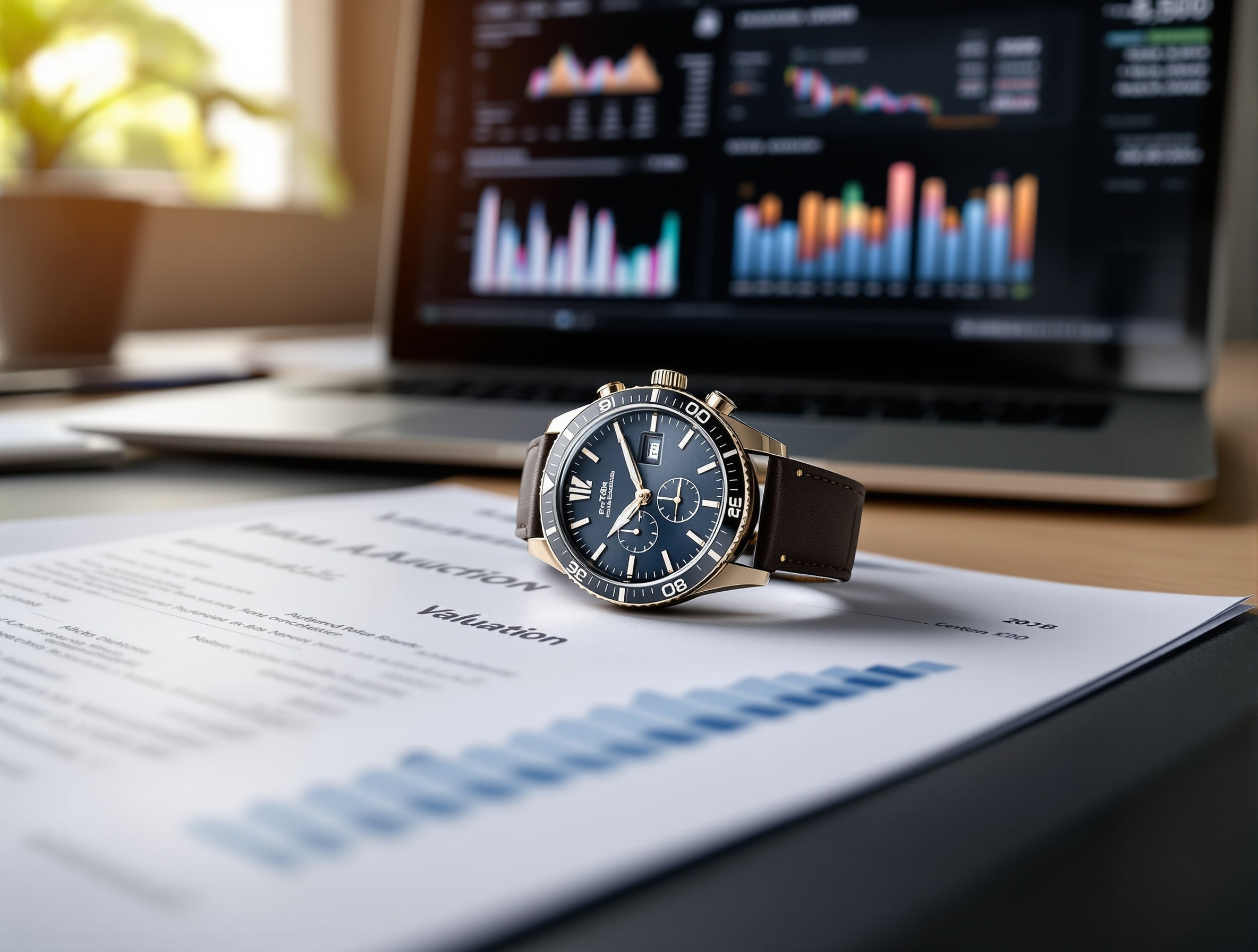Luxury watches are more than just accessories; they’re investments, heirlooms, and timeless pieces of art. Whether you own a Rolex Submariner, Patek Philippe Nautilus, or Omega Speedmaster, understanding your timepiece’s true worth starts with knowing how to get your perfect valuation for your watch.
A proper valuation goes far beyond checking online listings or comparing prices on forums. It’s a precise process that considers every element from authenticity, condition, and brand reputation to market demand and whether you have the original box, papers, and service history.
Getting an accurate valuation ensures you don’t undersell or overestimate your timepiece. It helps you make informed decisions, whether you plan to sell, insure, or simply appreciate the full value of your collection.
In this guide, we’ll explain what goes into achieving an accurate watch valuation, what documents and details you should prepare, and the expert steps that lead to the most reliable results.

What does “Perfect Valuation” mean?
When it comes to luxury timepieces, the term “perfect valuation” doesn’t just mean a high price; it means getting the most accurate, fair market value for your watch based on facts, not assumptions.
A perfect valuation reflects your watch's true worth in today’s market, accounting for every factor that can influence its desirability and price. It’s not simply what you paid when you bought it or what someone is asking online; it’s the price a knowledgeable collector, dealer, or buyer would realistically pay for it now.
The Difference Between Price and Value
Many watch owners confuse price with value. The price is what a seller lists the watch for, often inflated to test the market. The value, however, is a realistic assessment based on brand demand, condition, authenticity, and historical sales data.
A perfect valuation strikes the balance between market demand and individual watch characteristics, giving you a dependable number you can trust.
Why a Perfect Valuation Matters
Knowing the perfect valuation of your watch helps you make smarter financial and emotional decisions.
- For Selling: You’ll know the right price range to attract genuine buyers without underselling.
- For Insurance: It ensures your timepiece is adequately covered, avoiding disputes during claims.
- For Trading or Upgrading: It provides transparency when negotiating with dealers.
For Record Keeping: A precise valuation helps maintain your watch’s documented worth over time.
The Core of a Perfect Valuation
A perfect valuation goes beyond guesswork. It relies on a mix of:
- Technical Expertise: Understanding movement, reference numbers, and model history.
- Market Insight: Awareness of collector trends and resale data.
- Authenticity Verification: Confirming originality of parts and provenance.
- Condition Grading: Evaluating wear, service history, and overall preservation.
Prepare Your Watch for Valuation: The Checklist
Before you request a professional appraisal, having the correct information and accessories ready can make a significant difference. The more complete and transparent your watch’s details are, the more precise your valuation will be.
Use this checklist to prepare your timepiece for a flawless assessment:

1. Brand, Model, and Reference Number
Identify the exact model name and reference number engraved on the case or papers. This determines rarity, collectibility, and demand.
2. Serial Number
Note the serial number to confirm authenticity and production year. It helps valuers match your watch to specific manufacturing batches and historical data.
3. Original Box and Papers
Bring the complete set if available, including the original box, warranty card, manuals, and purchase receipts. Watches with complete documentation often command 10–20% higher valuations.
4. Service History and Maintenance Records
Provide all service receipts or certificates from authorized service centers. A well-maintained timepiece assures buyers and increases its market value.
5. Authentic Parts and Components
Ensure your watch has its original movement, dial, hands, and bracelet. Aftermarket parts or non-original components can lower the value significantly.
6. Overall Condition
Inspect for scratches, dents, or polishing. Case wear, crystal clarity, and bracelet tightness all influence valuation. Avoid unnecessary polishing before the assessment, as it can sometimes reduce collector value.
7. Material and Composition
Record the case material (stainless steel, gold, platinum, titanium, etc.) and any gemstones or special finishes. Precious metals and intricate craftsmanship often elevate worth.
8. Complications and Features
List unique features like chronograph, moonphase, GMT, or perpetual calendar. Complications typically add complexity and value.
9. Ownership and Provenance
If your watch has an interesting backstory or notable previous owner, include proof. Provenance adds authenticity and historical appeal.
10. Market Comparisons
Research similar models recently sold at reputable auction houses or marketplaces. This provides a baseline for what your watch might realistically achieve.
11. Authenticity Verification
Have your watch verified by a professional before the valuation. Documentation of authenticity builds trust and can prevent disputes later.
Major Value Drivers and How to Influence Them
Every watch tells a story, and so does its value. The perfect valuation isn’t just based on what brand is on the dial; it’s shaped by multiple factors that collectively determine what your timepiece is truly worth in today’s market.
Understanding these major value drivers will help you influence and even enhance your watch’s final valuation.

1. Brand and Model Prestige
Luxury names like Rolex, Patek Philippe, and Audemars Piguet hold exceptional resale value due to heritage and collector demand. Limited editions and discontinued models often fetch higher prices, so knowing your watch’s model and market reputation is essential for achieving the best valuation.
2. Materials and Craftsmanship
Gold, platinum, and titanium watches generally command higher values than steel. Exceptional craftsmanship, hand-finishing, and detailing further boost the worth. Preserve the original finish and avoid over-polishing; untouched authenticity always appeals more to collectors and valuers.
3. Condition and Originality
Condition is crucial. Original, unpolished watches with matching parts and minimal wear are valued higher. Avoid aftermarket modifications or replacements, as they reduce authenticity and price. Document every repair or service to prove your watch’s originality and care.
4. Completeness: Box, Papers, and Accessories
Having the original box, warranty card, and receipts can increase your valuation by up to 20%. These items prove authenticity and ownership, reassuring both valuers and buyers. Always keep your full set safe and complete.
5. Complications and Features
Complications such as chronographs, GMTs, or perpetual calendars enhance technical value. These complex functions reflect craftsmanship and increase desirability. Ensure all complications work properly regular servicing maintains performance and preserves value over time.
6. Provenance and Rarity
Limited-edition, discontinued, or celebrity-owned watches hold strong collector appeal. Provenance adds emotional and historical depth, making your piece stand out. Keep documentation of ownership or origin to strengthen authenticity and increase value.
7. Market Demand and Timing
Market trends heavily influence value. A model in high demand today might not hold the same tomorrow. Track recent sales, collector interest, and release cycles to time your valuation or sale when prices peak.
8. Authenticity and Verification
Authenticity is the foundation of value. Even small doubts or replaced parts can drastically lower the worth. Always have your watch professionally authenticated before valuation to establish trust and accuracy in the market.
9. Service History and Maintenance
A clean, verifiable service history reassures valuers and buyers that your watch is reliable. Regular servicing by authorized centers maintains performance and protects long-term value. Always retain service receipts as proof of proper care.
10. Market Comparables
Valuers compare recent sales of similar models to determine fair market value. Differences in condition, provenance, or completeness can affect price. Understanding where your watch stands among comparable listings ensures realistic expectations.
The Valuation Process Step-by-Step
A professional watch valuation follows a precise, transparent process designed to determine a fair and accurate market value. Here’s how experts assess your timepiece, from inspection to final report.
1. Initial Information Gathering
The process begins by collecting essential details: brand, model, serial number, and ownership documents. Providing a full set of information, including purchase receipts and service records, helps the valuer understand your watch’s background and ensures a more accurate assessment from the start.
2. Physical Inspection
An expert physically examines your watch to evaluate its condition, originality, and craftsmanship. They inspect the case, dial, bracelet, and movement under magnification, checking for wear, polishing, or replaced parts. This step determines authenticity and overall preservation quality.
3. Authenticity Verification
Authenticity is verified by cross-checking serial and reference numbers, movement engravings, and brand markings. Advanced tools or brand databases may be used to confirm genuine components. Verified authenticity not only builds confidence but also significantly impacts the final valuation figure.
4. Condition Grading
Your watch is graded based on its physical and mechanical condition categories like “mint,” “excellent,” or “good.” Factors include scratches, polish level, crystal clarity, and timekeeping accuracy. A higher condition grade typically translates to a stronger valuation and faster market demand.
5. Market Research and Comparables
Valuers analyze recent sales of similar watches across auctions, marketplaces, and dealer networks. This comparison establishes a fair market range for your model, adjusted for condition, age, and rarity. It ensures your valuation aligns with real-world buyer behavior, not inflated listings.
6. Adjustment for Completeness and Extras
If your watch includes its original box, papers, or additional straps, these extras are factored in. Conversely, missing documentation or replaced parts can lower the estimated value. Each element adds or subtracts a percentage based on collector preferences and demand.
7. Final Valuation and Report
After combining all findings, authenticity, condition, completeness, and market data, the valuer produces a formal report outlining the watch’s estimated market value. This document is essential for selling, insuring, or estate planning and provides a trustworthy benchmark for future reference.
Common Mistakes & How to Avoid Them
Even experienced watch owners can make minor errors that lead to inaccurate or undervalued appraisals. Avoid these common pitfalls to ensure your watch gets the valuation it truly deserves.

1. Relying on Online Listings
Online asking prices often inflate values and don’t reflect real sales. Always compare verified auction results or consult a professional for genuine market insights.
2. Assuming Older Means More Valuable
Age alone doesn’t guarantee value. Newer models in high demand may outperform vintage pieces. Focus on rarity, condition, and collector interest rather than age.
3. Over-Polishing or Modifying the Watch
Excessive polishing removes metal and softens edges, lowering collector appeal. Avoid cosmetic changes or aftermarket parts that compromise originality and long-term value.
4. Losing Box and Papers
Missing documentation can reduce valuation by up to 20%. Always store your box, warranty card, and receipts safely; they authenticate ownership and add credibility.
5. Ignoring Market Timing
Selling during low-demand periods can hurt returns. Monitor market trends and sell when collector demand peaks to achieve the best possible valuation.
6. Skipping Professional Authentication
Unverified watches raise suspicion among buyers and valuers. Always get professional authentication to confirm originality and protect against disputes or reduced appraisals.
7. Neglecting Regular Servicing
Skipping maintenance can harm performance and appearance. Regular servicing by authorized centers keeps your watch in top condition and preserves long-term value.
8. Overlooking Minor Defects
Small issues like worn straps or scratched crystals can influence value. Address minor repairs before valuation to improve presentation and perceived worth.
9. Not Researching Valuers
Choosing an inexperienced appraiser risks inaccurate results. Select a certified valuer with expertise in luxury watches to ensure a fair and professional assessment.
10. Forgetting Insurance Updates
Market values fluctuate. Failing to update your insurance after a new valuation can lead to undercoverage. Review and adjust policies regularly to stay protected.
Tips for Maximising Your Watch’s Value
To get the best possible price or appraisal, a few simple steps can make a big difference. Follow these proven tips to enhance your watch’s overall valuation.
- Keep your original box, warranty card, manuals, and receipts safely. A complete “full set” can increase your valuation by up to 20%.
- Service your watch regularly at authorized centers and retain all service receipts as proof of proper maintenance and care.
- Avoid over-polishing or replacing original parts. Preserving the watch’s authenticity maintains collector appeal and long-term value.
- Document your ownership, purchase details, and service history. A well-documented provenance builds buyer confidence and enhances desirability.
- Track market trends before selling. Wait for high-demand periods for your brand or model to maximize your return.
- Get multiple professional valuations to compare opinions and ensure you’re receiving a fair, accurate estimate of your watch’s market value.
When to Get a Professional Valuation And Who to Choose
Knowing when to seek a professional valuation and choosing the right expert ensures your watch’s worth is assessed accurately, transparently, and in line with current market standards.
1. When You’re Planning to Sell
Before selling, always get a certified valuation to understand your watch’s true market worth. It prevents underselling and strengthens your negotiation position when dealing with private buyers or luxury dealers.
2. When Insuring Your Watch
Insurance providers require an up-to-date valuation to determine coverage. A professional appraisal guarantees accurate documentation, ensuring your watch is fully protected in case of loss, theft, or damage.
3. When Your Collection Grows
If you’re building a collection, periodic valuations help track changing market trends and ensure your records remain current. It’s essential for investment-grade or vintage pieces that appreciate over time.
4. When You Inherit or Receive a Watch
Inherited or gifted watches often come without purchase details. A professional valuer can verify authenticity, assess current market value, and provide essential paperwork for insurance or estate documentation.
5. When the Market Changes
Watch markets fluctuate frequently. Major releases, celebrity influence, or global trends can impact values. Re-evaluating your watch every 12–18 months ensures your appraisal stays relevant to the current demand.
6. Choosing the Right Valuer
Select an experienced, certified watch specialist, ideally one affiliated with recognized appraisal bodies or luxury marketplaces. Look for transparency, reputation, and expertise in your brand to ensure a fair, professional valuation.
Conclusion
Getting your perfect valuation for your watch is about more than numbers; it’s about understanding craftsmanship, authenticity, and timing. By preparing the proper documents, maintaining originality, and seeking expert guidance, you ensure your timepiece receives the value it truly deserves. Whether you’re selling, insuring, or simply assessing its worth, a professional valuation offers confidence, accuracy, and peace of mind. Treat your watch as both an art piece and an investment, and its actual value will always shine through.

.png)



